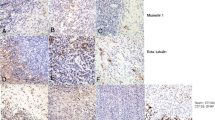Abstract
The role of stem cells in the origin, growth patterns, and infiltration of glioblastoma multiforme is a subject of intense investigation. One possibility is that glioblastoma may arise from transformed stem cells in the ventricular zone. To explore this hypothesis, we examined the distribution of two stem cell markers, activating transcription factor 5 (ATF5) and CD133, in an autopsy brain specimen from an individual with glioblastoma multiforme. A 41-year-old male with a right posterior temporal glioblastoma had undergone surgery, radiation, and chemotherapy. The brain was harvested within several hours after death. After formalin fixation, sectioning, and mapping of tumor location in the gross specimen, histologic specimens were prepared from tumor-bearing and grossly normal hemispheres. Fluorescence immunohistochemistry and colorimetric staining were performed for ATF5 and CD133. Both markers co-localized to the ependymal and subependymal zones on the side of the tumor, but not in the normal hemisphere or more rostrally in the affected hemisphere. ATF5 staining was especially robust within the diseased hemisphere in histologically normal ependyma. To our knowledge, this is the first in situ demonstration of stem cell markers in whole human brain. These preliminary results support the hypothesis that some glioblastomas may arise from the neurogenic zone of the lateral ventricle. The robust staining for ATF5 and CD133 in histologically normal ventricular zone suggests that an increase in periventricular stem cell activity occurred in this patient on the side of the tumor, either as a localized response to brain injury or as an integral component of oncogenesis and tumor recurrence.





Similar content being viewed by others
References
Sanai N, Alvarez-Buylla A, Berger MS (2005) Neural stem cells and the origin of gliomas. N Engl J Med 353:811–822
Sanai N, Tramontin AD, Quinones-Hinojosa A, Barbaro NM, Gupta N, Kunwar S, Lawton MT, McDermott MW, Parsa AT, Manuel-Garcia Verdugo J, Berger MS, Alvarez-Buylla A (2004) Unique astrocyte ribbon in adult human brain contains neural stem cells but lacks chain migration. Nature 427:740–744
Singh SK, Clarke ID, Terasaki M, Bonn VE, Hawkins C, Squire J, Dirks PB (2003) Identification of a cancer stem cell in human brain tumors. Cancer Res 63:5821–5828
Singh SK, Hawkins C, Clarke ID, Squire JA, Bayani J, Hide T, Henkelman RM, Cusimano MD, Dirks PB (2004) Identification of human brain tumour initiating cells. Nature 432:396–401
Quinones-Hinojosa A, Sanai N, Soriano-Navarro M, Gonzalez-Perez O, Mirzadeh Z, Gil-Perotin S, Romero-Rodriguez R, Berger MS, Garcia-Verdugo JM, Alvarez-Buylla A (2006) Cellular composition and cytoarchitecture of the adult human subventricular zone: a niche of neural stem cells. J Comp Neurol 494:415–434
Druckrey H, Ivankovic S, Preussmann R (1966) Teratogenic and carcinogenic effects in the offspring after single injection of ethylnitrosourea to pregnant rats. Nature 210:1378–1379
Lantos PL, Cox DJ (1976) The origin of experimental brain tumours: a sequential study. Experientia 32:1467–1468
Yaşargil M (1984) Microneurosurgery. Thieme Stratton, New York
Pilkington GJ, Lantos PL (1979) The development of experimental brain tumours a sequential light and electron microscope study of the subependymal plate. II. Microtumours. Acta Neuropathol (Berl) 45:177–185
Angelastro JM, Canoll PD, Kuo J, Weicker M, Costa A, Bruce JN, Greene LA (2006) Selective destruction of glioblastoma cells by interference with the activity or expression of ATF5. Oncogene 25:907–916
Angelastro JM, Ignatova TN, Kukekov VG, Steindler DA, Stengren GB, Mendelsohn C, Greene LA (2003) Regulated expression of ATF5 is required for the progression of neural progenitor cells to neurons. J Neurosci 23:4590–4600
Angelastro JM, Mason JL, Ignatova TN, Kukekov VG, Stengren GB, Goldman JE, Greene LA (2005) Downregulation of activating transcription factor 5 is required for differentiation of neural progenitor cells into astrocytes. J Neurosci 25:3889–3899
Mason JL, Angelastro JM, Ignatova TN, Kukekov VG, Lin G, Greene LA, Goldman JE (2005) ATF5 regulates the proliferation and differentiation of oligodendrocytes. Mol Cell Neurosci 29:372–380
Spassky N, Merkle FT, Flames N, Tramontin AD, Garcia-Verdugo JM, Alvarez-Buylla A (2005) Adult ependymal cells are postmitotic and are derived from radial glial cells during embryogenesis. J Neurosci 25:10–18
Globus J, Kuhlenbeck H (1944) The subependymal cell plate (matrix) and its relationship to brain tumors of the ependymal type. J Neuropathol Exp Neurol 3:1–35
Globus J, Kuhlenbeck H (1942) Tumors of the striatothalamic and related regions: their probable source of origin and more common forms. Arch Pathol 24:674–734
Eriksson PS, Perfilieva E, Bjork-Eriksson T, Alborn AM, Nordborg C, Peterson DA, Gage FH (1998) Neurogenesis in the adult human hippocampus. Nat Med 4:1313–1317
Zhu Y, Guignard F, Zhao D, Liu L, Burns DK, Mason RP, Messing A, Parada LF (2005) Early inactivation of p53 tumor suppressor gene cooperating with NF1 loss induces malignant astrocytoma. Cancer Cell 8:119–130
Assanah M, Lochhead R, Ogden A, Bruce J, Goldman J, Canoll P (2006) Glial progenitors in adult white matter are driven to form malignant gliomas by platelet-derived growth factor-expressing retroviruses. J Neurosci 26:6781–6790
Hanahan D, Weinberg RA (2000) The hallmarks of cancer. Cell 100:57–70
Johansson CB, Momma S, Clarke DL, Risling M, Lendahl U, Frisen J (1999) Identification of a neural stem cell in the adult mammalian central nervous system. Cell 96:25–34
Vescovi AL, Galli R, Reynolds BA (2006) Brain tumour stem cells. Nat Rev Cancer 6:425–436
Author information
Authors and Affiliations
Corresponding author
Rights and permissions
About this article
Cite this article
Schrot, R.J., Ma, J.H., Greco, C.M. et al. Organotypic distribution of stem cell markers in formalin-fixed brain harboring glioblastoma multiforme. J Neurooncol 85, 149–157 (2007). https://doi.org/10.1007/s11060-007-9401-8
Received:
Accepted:
Published:
Issue Date:
DOI: https://doi.org/10.1007/s11060-007-9401-8




